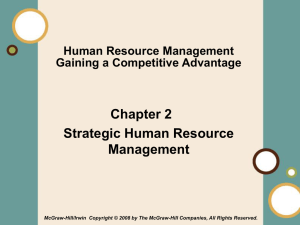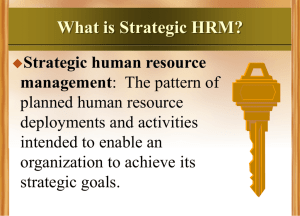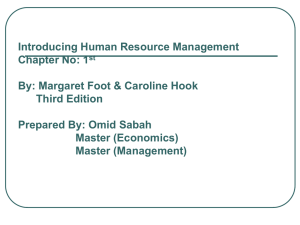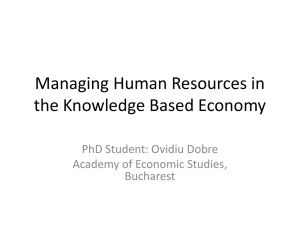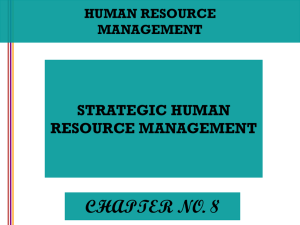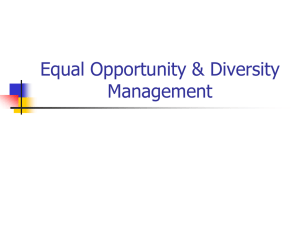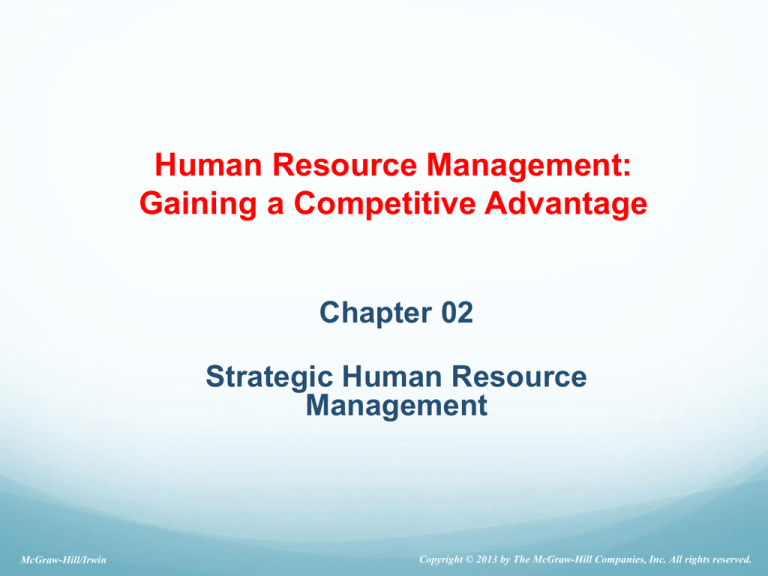
Human Resource Management:
Gaining a Competitive Advantage
Chapter 02
Strategic Human Resource
Management
McGraw-Hill/Irwin
Copyright © 2013 by The McGraw-Hill Companies, Inc. All rights reserved.
Learning Objectives
1. Describe the differences between strategy formulation and
strategy implementation.
2. List strategic management process components.
3. Discuss HRM function’s role in strategy formulation.
4. Describe the linkages between HRM and strategy
formulation.
5. Discuss typologies of strategies and associated
HRM practices.
6. Describe HR issues and practices associated with various
directional strategies.
2-2
Introduction
• Goal of strategic management is to deploy and
allocate resources in a way that gives an
organization competitive advantage.
• HRM function must be integrally involved in the
company’s strategic management process.
• A business model is how the firm will create
value for customers profitably.
2-3
What is Strategic Management?
Strategic human resource management (SHRM) is
the pattern of planned HR activities and deployments
intended to enable an organization to achieve its goals.
Strategic management is a process to address the
organization’s competitive challenges by integrating an
organization’s goals, policies and action sequences into
a cohesive whole.
2-4
Strategy
Implementation
Strategy
Formulation
2 Phases of
Strategic
Management
2-5
Strategic Management Process Model
Strategy Formulation
Strategy Implementation
HR Practices
Mission
Goals
Strategic
Choice
Internal
Analysis
•Strengths
•Weaknesses
HR
Needs
•Skills
•Behavior
•Culture
• Recruiting
• Training
• Performance management
• Labor relations
• Employee relations
• Job analysis
• Job design
• Selection
• Development
• Pay structure
• Incentives
•Benefits
HR
Capability
•Skills,
•Abilities
•Knowledge
2-6
Strategy- Competition Decisions
How?
2-7
Strategic Planning and HRM Linkages
Administrative
2-8
Strategy Formulation
External
Analysis
•Opportunities
•Threats
Internal
Analysis
•Strengths
•Weaknesses
2-9
SHRM-Strategy Formulation
Mission
Goals
Strategic Choice
Internal Analysis
2-10
SWOT Analysis for Google, Inc.
SWOT Analysis for Google Inc.
2-11
Strategy Implementation Variables
Organizational
Structure
Types
of
Information
Reward
Systems
Task
Design
Select
Train
Develop
People
2-12
HRM’s 3 Implementation Variables:
Task
2-13
Strategic Implementation
HR Practices
Human
Resource
Needs
•Skills
•Behavior
•Culture
•Recruiting
•Training
•Performance management
•Labor relations
•Employee relations
•Job analysis
•Job design
•Selection
•Development
•Pay structure
•Incentives
•Benefits
Human
Resource
Capability
•Skills,
•Abilities
•Knowledge
Human
Resource
Actions
•Behaviors
•Results
-productivity
-absenteeism
- turnover
2-14
HRM Practices
Recruitment
/Selection
2-15
Porter’s Strategies
Cost
2-16
5 Categories of Directional Strategies
Concentration
Internal Growth
External Growth
Mergers &
Acquisitions
2-17
Role Behaviors
Behaviors that are required of an individual
in his or her role as a jobholder in a social
work environment.
Different role behaviors are required for
different strategies.
2-18
Summary
Human Resources are the most important asset and
single largest most controllable cost within the business
model.
HR professionals must develop business,
professional-technical, change management and
integration competencies.
HRM has a profound impact on the strategic plan
implementation by developing and aligning HRM
practices that ensure the company has motivated
employees with necessary skills.
2-19

